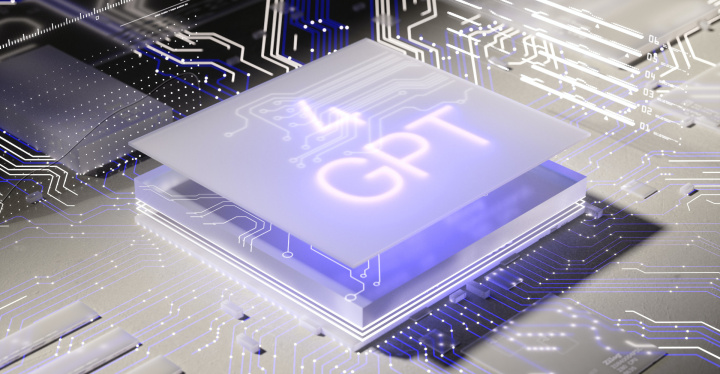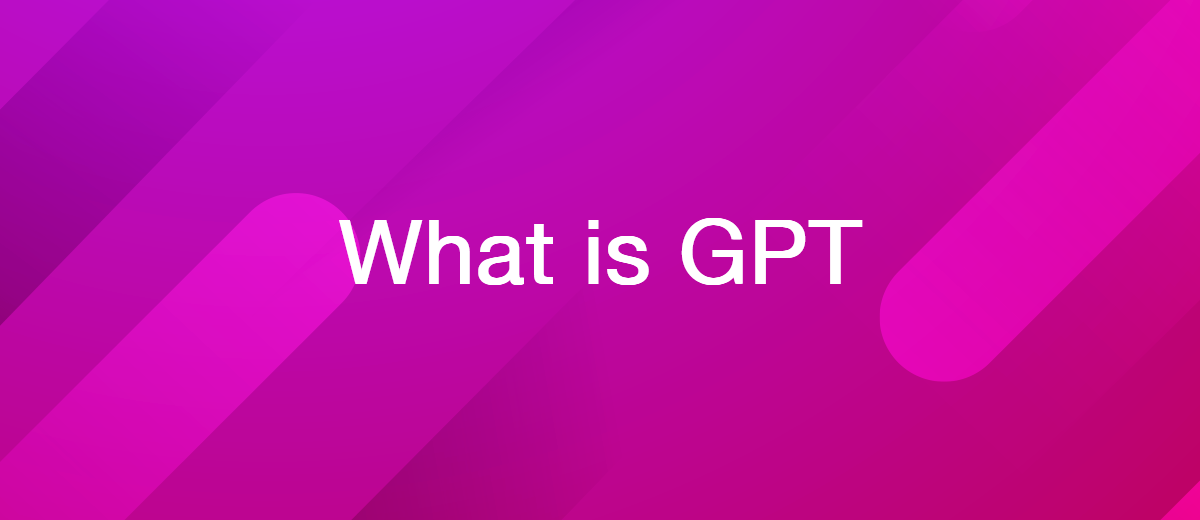GPT: What is It, Ways of Application, Development
The possibilities of artificial intelligence are becoming more extensive and impressive every year. One of the most promising data science technologies today is the GPT neural network, designed for natural language processing. Interest in it increased markedly in November 2022 – after the release of the public chatbot ChatGPT, based on this language model. With it, users can automate a variety of tasks, from generating code and preparing technical articles to writing poetry, making predictions, and image processing.
We decided to devote our new article to the GPT algorithm. From it, you will learn about what is GPT, what features and capabilities it has. We will also talk about how this technology was created, what tasks it copes with, in what areas it can be used, how to get access to GPT-3 and other models of the series. And also about the sensational chatbot ChatGPT and what innovations the latest version of the GPT-4 algorithm, introduced in March 2023, received.
What is GPT and How Does it Work?
GPT (Generative Pre-trained Transformer) meaning is a natural language processing algorithm that was released by the American company OpenAI. The main feature of a neural network is its ability to memorize and analyze information, creating a coherent and logical text on its basis. A powerful language model has a "transformer" architecture, which allows it to find relationships between individual words and calculate the most relevant sequence of words and sentences.

In simple terms, the GPT architecture is based on the principle of auto-completion – something like the T9 option works in smartphones. Based on one or more phrases or sentences, the algorithm can read, analyze and generate coherent and consistent text on this topic in the required volume. To date, GPT is considered the largest and most complex language model existing.
Technology Development: From Launch to GPT-4
This project began in 2017, when researchers from Google Brain presented a natural language processing model with a “transformer” architecture. Generative networks-transformers create phrases and sentences on a given topic from the most relevant words. They distribute them in an optimal sequence, as a person does in speech or writing. At the same time, transformers perform such tasks faster than other types of networks and use less computing resources. In June 2018, OpenAI published a document called "Improving Language Understanding by Generative Pre-Training", which described the model GPT – Generative Pre-trained Transformer. In the same year, the developers released the first full version of this neural network, called GPT-1.
GPT-1
The GPT-1 language model was created based on a “semi-managed” approach, which consists of two stages. In the first one (unsupervised generative pre-learning stage), language modeling is used to set the initial parameters. At the second (controlled fine-tuning stage), these parameters are pointwise adapted to the task at hand. To train the GPT-1 neural network, 4.5 GB of text from 7000 Internet pages and books of various genres were loaded into it, which provided it with 112 million parameters – variables that affect the accuracy of the algorithm.
GPT-2
After the successful release of the first version, OpenAI developed a bidirectional BERT neural network, which was considered the most advanced language model at that time. Then they started developing the second version of the GPT neural network and in the process changed the principle of its training. They realized that training a model based on a selection of texts from books and Wikipedia is not the most efficient way. Instead, the developers decided to use regular posts and comments from the Internet.
In February 2019, the OpenAI team released the next version of their language model, which is called GPT-2. It had the same architecture as GPT-2, but with modified normalization. For its training, an array of 8 million documents and 45 million web pages containing 40 GB of text was used. To make the input data more diverse, the developers took the pages of Internet forums as a basis. In particular, they took samples of posts from Reddit users with above-average ratings. This allowed the algorithms to digest only useful content, without spam and flooding. As a result, GPT-2 received 1.5 billion parameters – almost 10 times more than its predecessor.
GPT-3
What is GPT 3? The release of OpenAI GPT-3 took place in May 2020, when a team of specialists led by Dario Amodei posted an article detailing how it works. Unlike GPT-2, GPT-3 parameters did not receive cardinal changes in their architecture. However, it was modified for better scalability. Also, the new version of the neural network has a wider functionality, which allowed the developers to call their brainchild “suitable for solving any problems in English”. At the same time, access to GPT-3 was still unavailable to the mass user.
So, how does GPT-3 work? Unlike its predecessors, GPT-3 can remember much more information, so the text it generates is more logical and coherent. The Microsoft Azure AI supercomputer was used to train the language model. It was loaded with almost 600 GB of text, which included the entire English-language Wikipedia, fiction books with prose and poetry, materials from GitHub and news sites, as well as guides and recipes. GPT-3 power also provided a whole Common Crawl web archive with a trillion words. About 7% of the dataset consisted of texts in foreign languages, which significantly improved its ability to translate. The third version of the algorithm has 175 billion parameters, which again significantly exceeded the potential of its predecessor. In addition to generating texts, GPT-3 offers a number of other use cases: it can answer questions, perform semantic searches, and summarize. As of March 2021, the OpenAI text generating system spews out 4.5 billion words every day.
ChatGPT
In November 2022, OpenAI introduced its new product – the ChatGPT chatbot, developed based on the GPT-3.5 text generator. This version of the neural network was prepared specifically for the chatbot: it received more advanced features and was trained on more recent data (as of June 2021). By the way, the relevance of the data is an important feature and in some way a disadvantage of all versions of GPT. This means that when developing a neural network, data is loaded into it from the Internet at a certain point. Because of this, it knows nothing about newer events that occurred after the specified period.
ChatGPT is a conversational AI chatbot. It is based on an improved version of the GPT-3.5 language model, which was developed using different learning methods: supervised and reinforcement. The program can conduct a dialogue in real time, simulating human communication – it can even argue with the interlocutor. The chatbot also allows you to write program code and debug it, create music, write scripts, essays, poems, lyrics and other creative works. It can also answer questions from various tests, and does it better than the average person.
Unlike previous AI models, ChatGPT was trained not only thanks to texts, but also by interacting with a person. This was attended by special human trainers who acted out the communication models between the user and the AI. The deep learning model evolved based on these dialogs and tens of gigabytes of text loaded into it. Trainers then asked questions from ChatGPT and scored their responses, using their scores to create reward models. As a result, the chatbot learned and relearned for a long time, correcting the remarks based on the coach's assessments. This made it possible to achieve a very high degree of “humanity” in ChatGPT. After the release, the bot can save and analyze conversations with users, which will help it constantly improve its abilities.
GPT-4

On March 14, 2023, OpenAI released a new version of their language prediction model called GPT-4. Just like its predecessor, it is based on the "transformer" architecture and reinforcement learning. The developers claim that the new generation of the neural network turned out to be noticeably more powerful than GPT-3.5. This is a multimodal model that works not only with text, but also with images. It reads pictures, understands their content and context, and processes image-based queries. However, GPT-4 answers are still available only in text form: the neural network has not yet received the ability to draw on its own.
The image processing feature will be in beta testing for the first time after release, and will become available to the public at a later date. GPT-4 also has advanced text processing capabilities. Its RAM now holds up to 25,000 words, which it can read, parse and generate. For example, a neural network is capable of writing a literary work, a large legal contract, or even code for a full-fledged program. At the same time, it better recognizes the context and more accurately adheres to the style of answers given to it. According to its creators, GPT-4 has become more creative, adapts more flexibly to the user and works more efficiently with “thin scenarios”.
Another important advantage of the 4th version of the neural network was its improved ability to take exams and tests in various subjects. It excelled in a number of disciplines, outperforming its GPT-3.5 predecessor, not to mention the average person. GPT-4 also translates text more accurately: the developers tested it in 26 languages, and in 24 cases the result was higher than that of GPT-3.5 in its native English. At the same time, the language model still does not have the latest data (information is loaded into it as of autumn 2021) and sometimes makes mistakes – most often when working with program code.
OpenAI has already implemented the GPT-4 language model in its ChatGPT intelligent chatbot. To date, it is available only to users with a paid Plus subscription and is limited to 100 requests within 4 hours. In addition, users of the Bing web browser from Microsoft and Duolingo language learning service can test the capabilities of the new algorithm.
Areas and Ways of Application
Next, it's worth talking about how to use GPT-3, GPT-4 and ChatGPT. These technologies have a huge number of areas and applications, the main ones are:
- Generation of texts on various topics up to 25,000 words in dozens of languages, as well as their translation from one language to another.
- Image processing, which became available with the advent of the 4th version of the algorithm. The neural network not only recognizes objects in images, but also understands their context. For example, it can explain what the meaning of a meme picture is or what is unusual/funny shown in the photo.
- Writing program code and consulting users in this area. For example, GPT can suggest how to perform a particular operation or process. It can also find bugs in the code and translate it from one programming language to another. GPT-4's capabilities are even more extensive: you can send it a hand-drawn (manually or in the editor) site or application template so that it writes the code for the corresponding software.
In addition, the language model has a number of other areas of application: writing poetry, scripts, essays and compositions, lyrics and notes, journalistic and technical articles, preparing medical recommendations, creating plans, calculations and forecasts, conducting financial analysis, generating requests for others, neural networks, etc.
Alternatives to GPT
In addition to the Generative Pre-trained Transformer, there are a number of other generative neural networks for creating text or images today. The most famous among them are:
- OPT. The Open Pre-trained Transformer language model developed by Meta Corporation has 175 billion parameters. It has been trained on a number of public datasets, including The Pile and BookCorpus. This neural network combines pre-trained models and self-learning source code.
- Alexa™ 20B. Amazon has released AlexaTM 20B, a large-scale multilingual sequence2sequence model. It supports Few-Shot Learning (FSL) machine learning technology and has 20 billion parameters. The algorithm is capable of generating and translating text into and from a number of languages, including English, Spanish, Arabic, French, Hindi, Japanese, Portuguese, Italian and others.
- CodeGen. The neural network from Salesforce can write program code based on simple text prompts, without requiring programming skills from users. The model is based on conversational AI technology and helps to automate code writing using artificial intelligence.
- LaMDA. The language model developed by Google is optimal for conducting dialogues with users on various topics. It is also capable of making lists and can be trained to communicate in depth on selected topics. The LaMDA dialog model is highly scalable and respects previous context when processing requests.
- Claude. Anthropic, a startup founded by former OpenAI employees, has released a new chatbot Claude, which is considered a full-fledged alternative to ChatGPT. It has almost the same functionality: it can generate text, search for information in documents, translate texts into different languages, write program code, etc. The developers claim that Claude gives more accurate answers and is easier to manage.
Conclusions
The emergence of GPT and other language models has become an important step towards the introduction of artificial intelligence into the life of a modern person. At the same time, the capabilities of generative neural networks described in this article are far from the limit of their development. Already in the coming years, AI technologies can have a huge impact on changing the labor market, replacing many professions in demand now in the field of trade, marketing, customer service and other industries. They will be replaced by fundamentally new specialties focused on interaction with artificial intelligence.
Apix-Drive is a universal tool that will quickly streamline any workflow, freeing you from routine and possible financial losses. Try ApiX-Drive in action and see how useful it is for you personally. In the meantime, when you are setting up connections between systems, think about where you are investing your free time, because now you will have much more of it.

